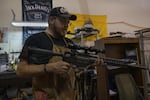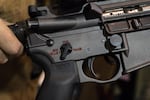The AR-15 has taken center stage in the American gun debate. But at its heart, the AR-15 is a rifle that has been modified to look and feel a certain way.
The emphasis on its appearance, however, has shaped how the country regulates firearms, to the frustration of many gun owners and gun control advocates alike.
The AR-15 is a semiautomatic rifle that usually shoots 5.56 mm rounds. It has a detachable magazine so users can put in 5-, 10-, 30-, or even 60- and 100-round magazines.
The rifle that likely comes to mind is black and has any number of aftermarket attachments. Maybe there’s a grip attached under the barrel or a scope that, to some, might look like it’s made for a sniper. The rifle is easily customized and that’s part of its popularity. But it’s also the source of a running joke in the firearms community.
“I get ARs in here that weigh 20 pounds they have so much shit on them,” said Jon Bush, a gunsmith in Vancouver, Washington. “Whatever you want to put on, including your coffee grinder.”
Bush is a competitive shooter and said the AR-15 is great for that.
“Any platform you can shoot faster and accurate for competition gives you an edge,” Bush said. But, he added, “hunting-wise, an AR is not that great.”
He thinks people love their ARs for other reasons. It’s an image.
“It's got that little ‘tacticool’ look to it and you can go out and see the range ninjas playing around and everything,” he said.

Jon Bush, a gunsmith in Vancouver, WA, holds his AR-15 in his shop. Bush says the AR-15’s popularity has largely to do with the rifle’s appearance.
Jonathan Levinson / OPB
And Bush said this obsession with how the gun looks is most obvious when comparing the AR-15 to another gun: the Mini-14. That's also a semi-automatic rifle, but it has a wood frame. It looks more like your grandpa's hunting rifle than something SEAL Team 6 might carry.
“They operate the exact same way,” Bush said. “More often than not, they shoot the same round, too, with the same capacity. One is just scary looking.”
Unlike the AR-15, however, the Mini-14 is neither adored, nor vilified. Most people have never heard of it.
Selling An Emotional Response
Guns are not just tools in modern America. There is a lot of emotion wrapped up in people’s decisions around firearms, according to Kiersten Muenchinger, a product design professor at the University of Oregon who studies how Americans give meaning to guns far beyond their functional purpose.
“It’s such a jumble with how we feel about having firearms, having lots of firearms, being able to have any kind of firearm, having a collection of firearms,” she said.
In trying to understand the focus on the AR-15, Muenchinger said we can take a cue from product design.
“An aspect of what you're looking for in your newly designed product is craveability and [that] it triggers some emotional response,” she said.
Today, the emotional response that typically sells guns is about war.
Take, for instance, FN Herstal, a Belgian company that makes civilian and military firearms, including the M2 Browning .50-caliber machine gun and the M249 light machine gun.
In a commercial the company released in 2016, a video plays of bearded soldiers in Humvee turrets and patrolling through fog, shooting machine guns at an out-of-frame enemy. Over the video, a baritone narrator with a grizzled voice reads, "We are warriors, shouldered by the bravest of the brave, we are tortured, tested on the battlefields, cherished in foxholes, and proven worthy in the trenches."

Jon Bush holds a Spike's Tactical AR-15 with “war” and “peace” in place of “safe” and “fire” on the rifle’s safety selector switch.
Jonathan Levinson
Tom Diaz, a staff attorney in the 1990s for the U.S. House Subcommittee on Crime and Criminal Justice who helped pass the 1994 Assault Weapons Ban, said FN isn’t alone.
“If you look at industry ads,” Diaz said, “in many of the magazines and particularly in their catalogs, you will see that they play directly to this image of the armed person in the military.”
Related: The Masculine Ideal Is Killing American Men
And that is potentially dangerous. Frequent imagery glorifying military violence can make it seem normal and possibly a little easier to commit for someone already predisposed to violence.
“There is a subset of people,” Diaz said, “for whom I do think the bar has been lowered, partly through industry advertising, partly through incautious language by some of our leaders and partly through just plain provocative language from people at extremes.”
Violent imagery has also taken over the discussions around gun control — to the annoyance of some gun owners and the frustration of people trying to change laws.
“Most of the politicians who deal with this issue, they don't really have a clue about guns,” Diaz lamented.
Can You Ban An Image?
Democratic presidential candidate Beto O’Rourke has drawn attention lately for saying an O’Rourke administration would push to ban certain rifles, after a mass shooting in his hometown of El Paso, Texas, left 22 people dead. On CNN recently, he was asked to elaborate.
“When it comes to AR-15s and AK47s ... that belongs on the battlefield; it does not belong in this country,” O’Rourke told host Chris Cuomo. “But when it comes to firearms used for hunting or self-defense the answer is, ‘No.’”

The Ruger Mini-14 (top) is identical in function to the AR-15 (bottom) but isn’t as popular as the AR-15 and is largely ignored by gun control advocates and policymakers.
Jonathan Levinson / OPB
O’Rourke did not explain what differentiates a hunting rifle from an AR-15, but Congress has tried. In 1994, the same day it narrowly passed in the Senate, President Bill Clinton signed into law the Assault Weapons Ban, which expired in 2004.
The legislation banned a handful of specific makes and models and certain features, but it did little to address the underlying lethal aspects of the weapons.
The law did not ban all semi-automatic firearms, but it banned most AR- and AK-type rifles. If your rifle had a pistol grip, you were probably in the clear. Same if it had a bayonet mount. But if your rifle had both, then you might have had an issue.
Diaz, the U.S. House attorney, worked on the bill but thinks it took the wrong approach.
“The 1994 definition was ludicrous,” Diaz said. “Things like a bayonet mount — I mean, what the hell does that have to do with firepower? Almost nothing.”
Predictably, loopholes abounded and most research concluded the 1994 ban didn't really work to reduce gun violence. (A soon-to-be-released Stanford study found it did decrease the frequency of mass shootings.)
Firearms companies just tweaked their designs to make them compliant while selling essentially the same guns, a problem California and Connecticut continue to have with their respective assault weapons bans.
Diaz said people need to stop obsessing over looks and just ban the one capability that makes guns so deadly: high-capacity magazines.
“Let's make it eight rounds, no grandfathering,” he said. “So all of these 10-, 20-, 30-, 40-, 60-, 90-, 100-round magazines become contraband after a grace period.”
He said an AR- style rifle loaded with eight rounds is a whole different creature than an AR with 60.
Guns & America is a public media reporting project on the role of guns in American life.
